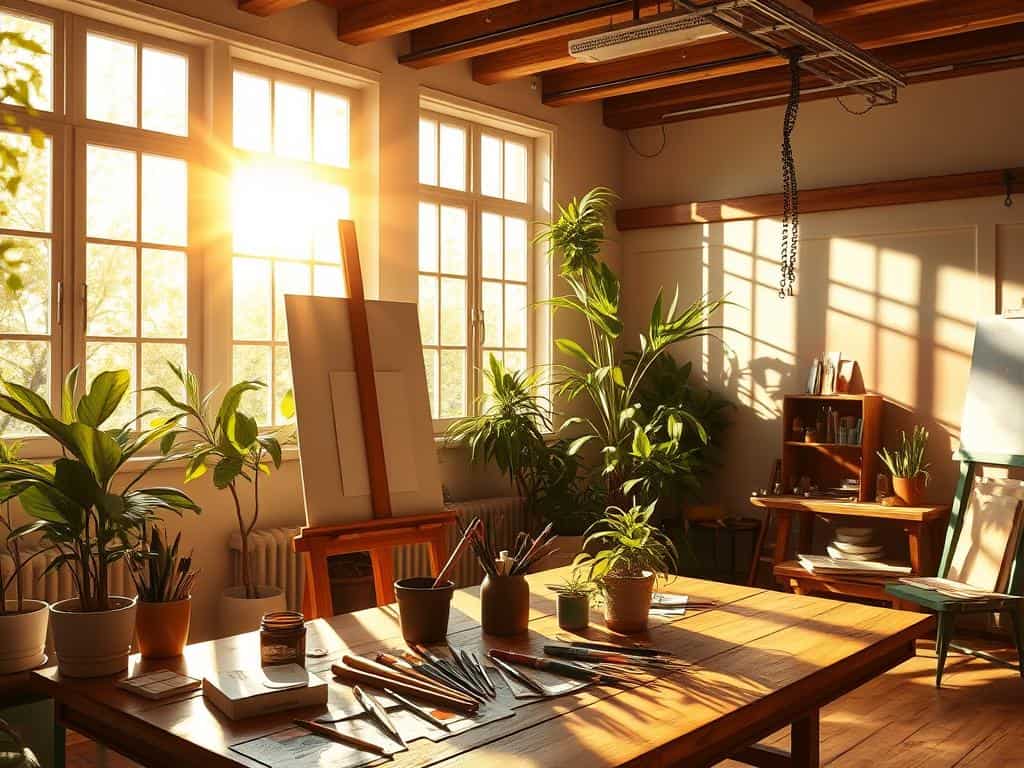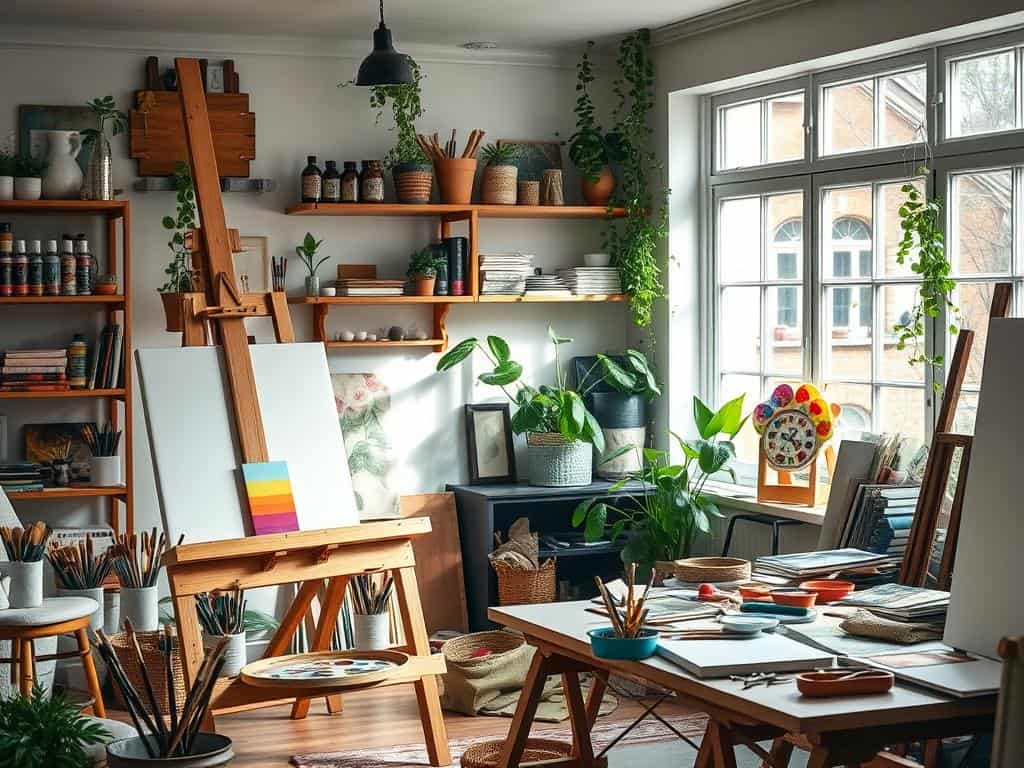Turning a corner of my living room into an art studio changed my creativity. It started with a sudden urge to create, inspired by a beautiful sunset. I set up my easel and paints, and the natural light from the window sparked my creativity.
I learned how important a well-planned art studio is for creativity and productivity. Through trial and error, I transformed my space. Now, I want to share eight key tips for setting up your own inspiring home art studio.
Key Takeaways
- Natural light is key; 75% of art experts say it’s essential for home studios.
- LED shop lights are a good investment, 25% of art pros agree.
- Good storage is vital, 22% stress its importance.
- A flexible layout boosts creativity, 2 out of 8 experts say.
- Repurposing containers helps organize, 7% of art experts suggest.
- Soundproofing reduces distractions, 12.5% of professionals recommend.
Choosing the Right Space for Your DIY Art Studio Setup
Finding the perfect spot for my art studio is key. Natural light is a big deal for artists. It affects how I see colors and helps prevent eye strain, making my work more fun.
North-facing windows are great. They give indirect light all day, perfect for painting and drawing.
Natural Light Considerations
When picking a studio, windows and their position matter a lot. Natural light makes my art better. But, big windows or skylights need careful placement to avoid harsh sun.
Strategically placing my workspace helps use light best.
Isolation and Privacy in Your Creative Space
Having a private space is key for focus. If I share a studio, soundproofing helps block out distractions. A special area for my art makes it easier to get into the zone.
Ventilation and Access to Utilities
Good air flow is important, as some art supplies can smell bad. I look for studios with big windows and an exhaust system. Easy access to water and electricity also boosts my productivity, letting me focus on my art.

Planning Your Layout for Maximum Efficiency
After finding the perfect spot for my art studio, I started planning the layout. A good layout makes my workflow smooth, letting me easily switch between painting and drawing. I made sure there’s enough room to move and that tools are easy to reach, all while keeping creativity flowing.
Designing Your Workspace
I knew natural light was key for my workspace. North-facing windows gave me consistent, indirect light, ideal for artists. This light reduces shadows and keeps the area bright. I also added adjustable task lights for better visibility on detailed projects. This made my workspace a place of creativity and comfort.
Storage Solutions for Art Supplies
Organizing art supplies is vital for a smooth studio. I sorted them by type and size for quick access. I used clear containers and labeled shelves to avoid confusion. Wall shelves and rolling carts helped keep the floor clear, making it easy to find what I need.
Creating an Inspiration Corner
An inspiration corner is a big part of my studio. It’s filled with art pieces, photos, and personal items that spark my creativity. This corner turned a simple spot into a burst of ideas, reminding me of the endless possibilities in my art space.

Prioritizing Comfort and Ergonomics
Creating a great art studio starts with a comfy environment. Comfort and ergonomics boost my creativity and productivity. Good seating and lighting are key for long work hours.
Investing in Quality Seating
Good seating is vital for avoiding fatigue during long studio hours. An ergonomic chair or stool supports my back, letting me focus on my art. Comfortable seating keeps my creative flow going, whether I’m working on big canvases or small details.
Choosing the right seat for my body is important. It helps me stay in the right posture during art sessions.
Optimal Lighting for Your Art Projects
Studio lighting affects how I see colors and work efficiently. A mix of natural light and adjustable task lighting is best. High Color Rendering Index (CRI) lighting over 90 shows true colors and reduces shadows.
Having a north-facing window in my studio gives me consistent light. Adding overhead lights or lamps makes the space bright and even.
Climate Control Strategies for Comfort
Controlling the studio’s climate is key for comfort and productivity. Good ventilation is important, as it helps with paint smells. Keeping the room at a steady temperature and humidity level keeps my art supplies and me comfortable.
This mix of seating, lighting, and climate control makes my studio perfect for art. It supports my creative work.
Conclusion
Setting up a DIY art studio at home is a thrilling adventure. It mixes creativity with smart organization. By picking the right spot and planning the layout, I can turn any area into a creative haven.
These tips show how to mix comfort with efficiency. This makes my workspace both beautiful and good for creating.
As I worked on this, I learned how key creative space organization is. Using vertical storage and old items can save space. Old Mason jars and Ikea furniture make my space lively and easy to use.
My art studio is more than a place to work. It’s a place where my creativity grows. By using these ideas, I improve my art and create a space that inspires me.
With a bit of creativity and planning, my studio is ready for all my art projects. It’s a place where every brushstroke and sketch can come to life.



